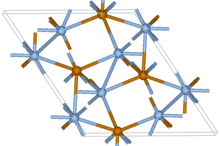Silver telluride

| |
| Names | |
|---|---|
| Other names | |
| Identifiers | |
3D model (
JSmol ) |
|
ECHA InfoCard
|
100.031.277 |
PubChem CID
|
|
| |
| |
| Properties | |
| Ag2Te | |
| Molar mass | 341.3364 g/mol |
| Appearance | grey-black crystals |
| Density | 8.318 g/cm3 |
| Melting point | 955 °C (1,751 °F; 1,228 K) |
Refractive index (nD)
|
3.4 |
| Structure | |
Monoclinic, mP12
| |
| P21/c, No. 14 | |
Except where otherwise noted, data are given for materials in their standard state (at 25 °C [77 °F], 100 kPa).
| |
Silver telluride (Ag2Te) is a chemical compound, a
Silver(I) telluride occurs naturally as the mineral hessite, whereas silver(II) telluride is known as empressite.
Silver telluride is a semiconductor which can be doped both n-type and p-type. Stoichiometric Ag2Te has n-type conductivity. On heating silver is lost from the material.
Synthesis
Porous silver telluride (AgTe) is synthesized by an electrochemical deposition method. The experiment can be performed using a potentiostat and a three-electrode cell with 200 mL of 0.5 M sulfuric acid electrolyte solution containing Ag nanoparticles at room temperature. Then a silver paste used in the tungsten ditelluride (WTe2) attachment leach into the electrolyte which causes small amounts of Ag to dissolve in the electrolyte. The electrolyte was stirred by a magnetic bar to remove hydrogen bubbles. A silver- silver chloride electrode and a platinum wire can be used as reference and counter electrodes. All the potentials can be measured against the reference electrode, and it was calibrated using the equation ERHE = EAg/AgCl + .059 pH + .197. In order to grow the porous AgTe, the WTe2 was treated using multiple cyclic voltammetry between -1.2 and 0 volts with a scan rate of 100 mV/s.[1]
Glutathione coated Ag2Te Nanoparticles can be synthesized by preparing a 9 mL solution containing 10 mM AgNO3, 5mM Na2TeO3, and 30 mM glutathione. Place that solution in an ice bath. N2H4 was added to the solution and the reaction is allowed to proceed for 5 min under constant stirring. Then the nanoparticles are washed three times by a way of centrifugation, after the three washes the nanoparticles are suspended in PBS and washed again with that same method.[2]
References
- Aliev, F. F. (2002). "Phase Transition of Ag_Enriched Ag2Te". Inorganic Materials. 38 (10): 995–997. S2CID 91815176.
- Chuprakov, I. S.; Dahmen, K. H. (1998). "Large positive magnetoresistance in thin films of silver telluride". Applied Physics Letters. 72 (17): 2165. doi:10.1063/1.121309.
- Dalven, Richard (1966). "Fundamental Optical Absorption in β-Silver Telluride". Physical Review Letters. 16 (8): 311. .
- Hagyeong Kwon, Dongyeon Bae, Dongyeun Won, Heeju Kim, Gunn Kim, Jiung Cho, Hee Jung Park, Hionsuck Baik, Ah Reum Jeong, Chia-Hsien Lin, Ching-Yu Chiang, Ching-Shun Ku, Heejun Yang, and Suyeon Cho "Nanoporous Silver Telluride for active hydrogen evolution." (n.d.) https://pubs.acs.org/doi/10.1021/acsnano.0c09517
See also
Related materials
- Silver selenide
- Silver sulfide
